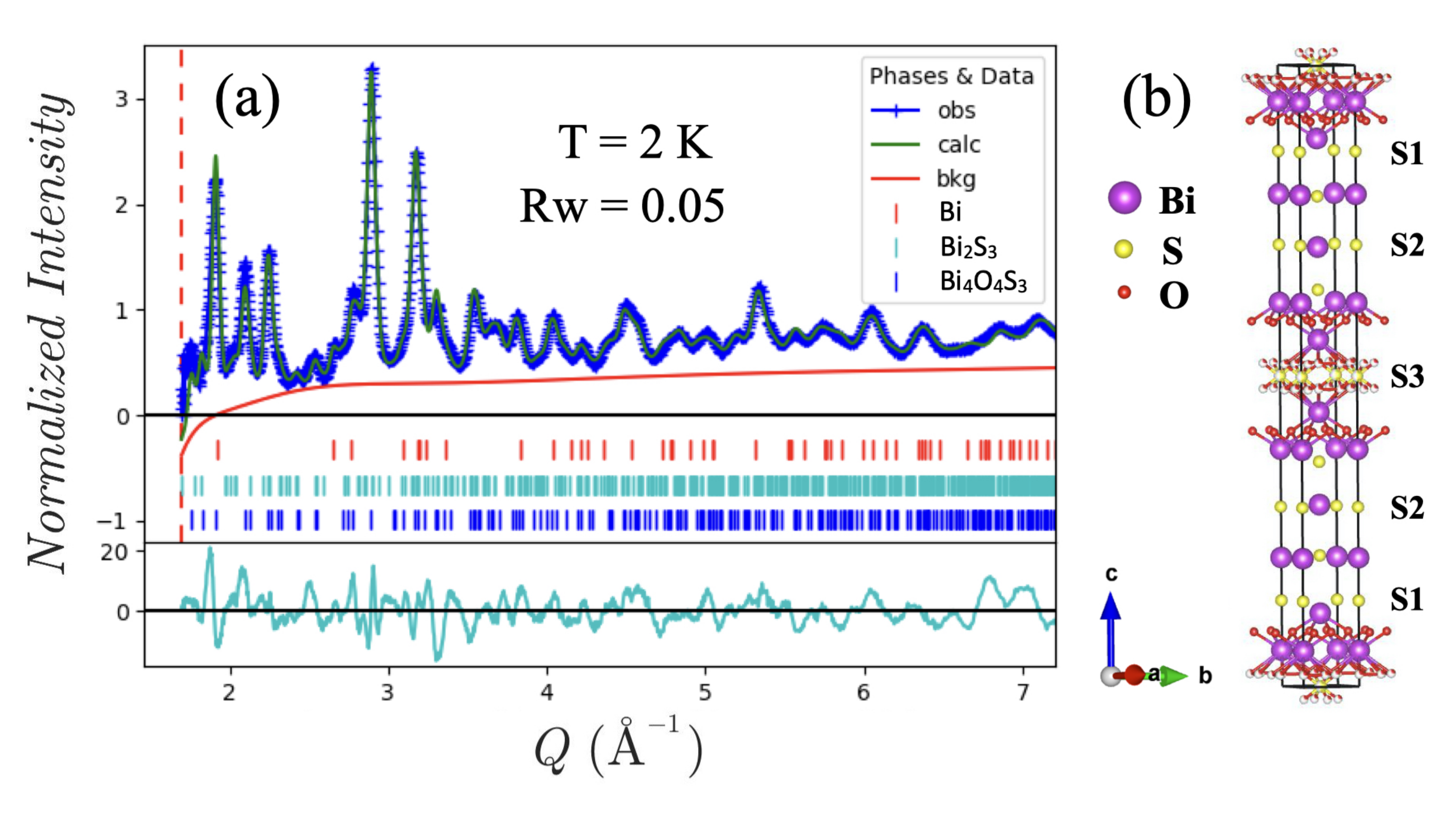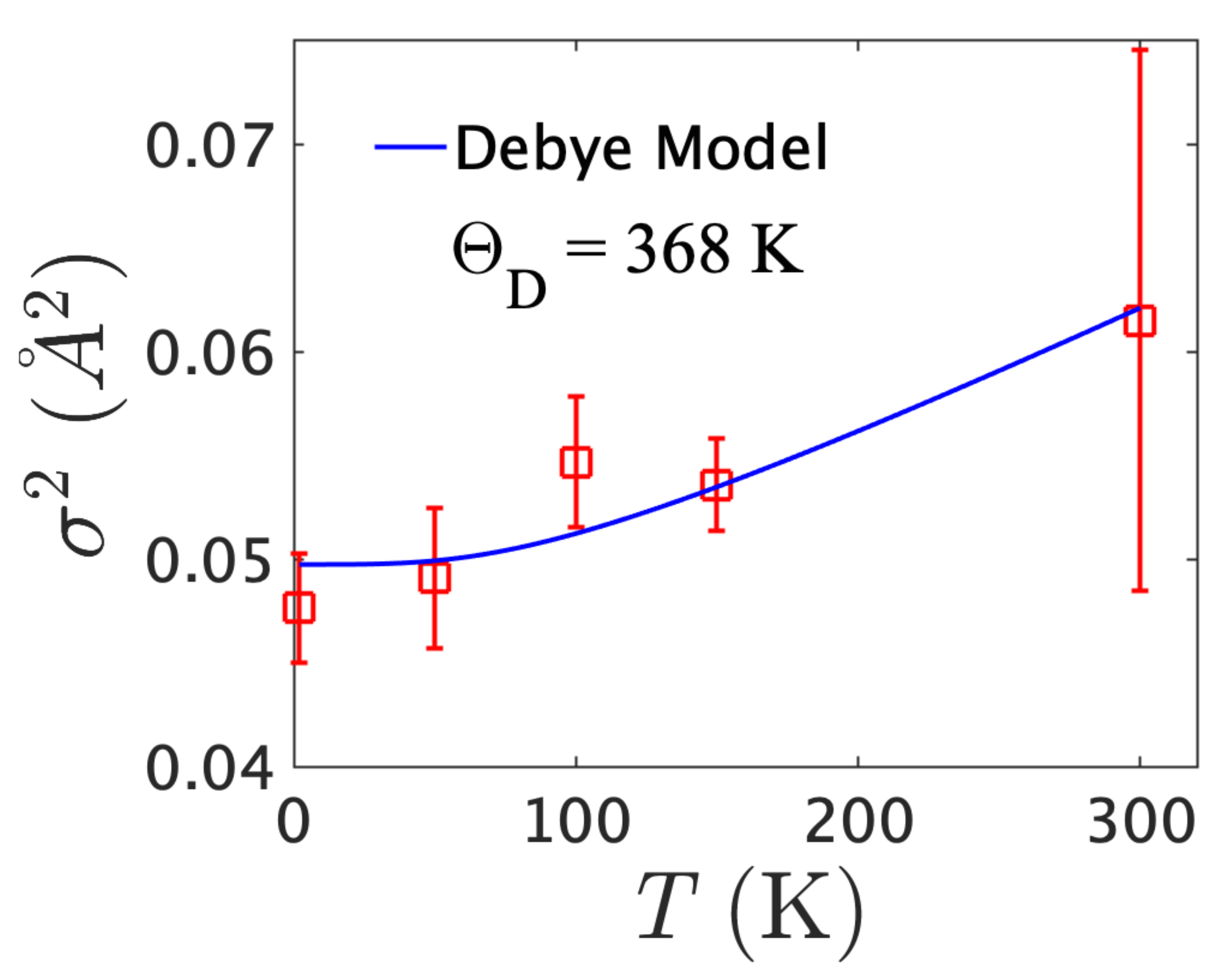Out-of-Plane Sulfur Distortions in the Bi4O4S3 Superconductor
Abstract
:1. Introduction
2. Results and Discussion
3. Materials and Methods
4. Conclusions
Author Contributions
Funding
Data Availability Statement
Acknowledgments
Conflicts of Interest
References
- Egami, T.; Louca, D.; McQueeney, R. Nonuniform metallic state in manganites and cuprates. J. Supercond. 1997, 10, 323–327. [Google Scholar] [CrossRef]
- Mizuguchi, Y.; Fujihisa, H.; Gotoh, Y.; Suzuki, K.; Usui, H.; Kuroki, K.; Demura, S.; Takano, Y.; Izawa, H.; Miura, O. BiS2-based layered superconductor Bi4O4S3. Phys. Rev. B 2012, 86, 220510. [Google Scholar] [CrossRef] [Green Version]
- Mizuguchi, Y.; Demura, S.; Deguchi, K.; Takano, Y.; Fujihisa, H.; Gotoh, Y.; Izawa, H.; Miura, O. Superconductivity in Novel BiS2-Based Layered Superconductor LaO1-xFxBiS2. J. Phys. Soc. Jpn. 2012, 81, 114725. [Google Scholar] [CrossRef] [Green Version]
- Demura, S.; Mizuguchi, Y.; Deguchi, K.; Okazaki, H.; Hara, H.; Watanabe, T.; James Denholme, S.; Fujioka, M.; Ozaki, T.; Fujihisa, H.; et al. New Member of BiS2-Based Superconductor NdO1-xFxBiS2. J. Phys. Soc. Jpn. 2013, 82, 033708. [Google Scholar] [CrossRef]
- Xing, J.; Li, S.; Ding, X.; Yang, H.; Wen, H.H. Superconductivity appears in the vicinity of semiconducting-like behavior in CeO1-xFxBiS2. Phys. Rev. B 2012, 86, 214518. [Google Scholar] [CrossRef] [Green Version]
- Usui, H.; Suzuki, K.; Kuroki, K. Minimal electronic models for superconducting BiS2 layers. Phys. Rev. B 2012, 86, 220501. [Google Scholar] [CrossRef] [Green Version]
- Kotegawa, H.; Tomita, Y.; Tou, H.; Izawa, H.; Mizuguchi, Y.; Miura, O.; Demura, S.; Deguchi, K.; Takano, Y. Pressure study of BiS2-based superconductors Bi4O4S3 and La(O, F)BiS2. J. Phys. Soc. Jpn. 2012, 81, 103702. [Google Scholar] [CrossRef] [Green Version]
- Deguchi, K.; Mizuguchi, Y.; Demura, S.; Hara, H.; Watanabe, T.; Denholme, S.; Fujioka, M.; Okazaki, H.; Ozaki, T.; Takeya, H.; et al. Evolution of superconductivity in LaO1-xFxBiS2 prepared by high-pressure technique. EPL (Europhys. Lett.) 2013, 101, 17004. [Google Scholar] [CrossRef] [Green Version]
- Yildirim, T. Ferroelectric soft phonons, charge density wave instability, and strong electron-phonon coupling in BiS2 layered superconductors: A first-principles study. Phys. Rev. B 2013, 87, 020506. [Google Scholar] [CrossRef] [Green Version]
- Wan, X.; Ding, H.C.; Savrasov, S.Y.; Duan, C.G. Electron-phonon superconductivity near charge-density-wave instability in LaO0.5F0.5BiS2: Density-functional calculations. Phys. Rev. B 2013, 87, 115124. [Google Scholar] [CrossRef] [Green Version]
- Zhang, X.; Liu, Q.; Luo, J.W.; Freeman, A.J.; Zunger, A. Hidden spin polarization in inversion-symmetric bulk crystals. Nat. Phys. 2014, 10, 387–393. [Google Scholar] [CrossRef] [Green Version]
- Mazziotti, M.V.; Valletta, A.; Raimondi, R.; Bianconi, A. Multigap superconductivity at an unconventional Lifshitz transition in a three-dimensional Rashba heterostructure at the atomic limit. Phys. Rev. B 2021, 103, 024523. [Google Scholar] [CrossRef]
- Yazici, D.; Huang, K.; White, B.; Chang, A.; Friedman, A.; Maple, M. Superconductivity of F-substituted LnOBiS2 (Ln = La, Ce, Pr, Nd, Yb) compounds. Philos. Mag. 2013, 93, 673–680. [Google Scholar] [CrossRef] [Green Version]
- Kamihara, Y.; Watanabe, T.; Hirano, M.; Hosono, H. Iron-based layered superconductor La[O1-xFx] FeAs (x = 0.05 − 0.12) with Tc = 26 K. J. Am. Chem. Soc. 2008, 130, 3296–3297. [Google Scholar] [CrossRef]
- Athauda, A.; Yang, J.; Lee, S.; Mizuguchi, Y.; Deguchi, K.; Takano, Y.; Miura, O.; Louca, D. In-plane charge fluctuations in bismuth-sulfide superconductors. Phys. Rev. B 2015, 91, 144112. [Google Scholar] [CrossRef] [Green Version]
- Singh, S.K.; Kumar, A.; Gahtori, B.; Sharma, G.; Patnaik, S.; Awana, V.P. Bulk superconductivity in bismuth oxysulfide Bi4O4S3. J. Am. Chem. Soc. 2012, 134, 16504–16507. [Google Scholar] [CrossRef] [Green Version]
- Conradson, S.; Raistrick, I.D. The axial oxygen atom and superconductivity in YBa2Cu3O7. Science 1989, 243, 1340–1343. [Google Scholar] [CrossRef]
- Bianconi, A.; Saini, N.; Lanzara, A.; Missori, M.; Rossetti, T.; Oyanagi, H.; Yamaguchi, H.; Oka, K.; Ito, T. Determination of the Local Lattice Distortions in the CuO2 Plane of La1.85Sr0.15CuO4. Phys. Rev. Lett. 1996, 76, 3412. [Google Scholar] [CrossRef] [Green Version]
- Bianconi, A.; Lusignoli, M.; Saini, N.; Bordet, P.; Kvick, Å.; Radaelli, P. Stripe structure of the CuO2 plane in Bi2Sr2CaCu2O8+y by anomalous X-ray diffraction. Phys. Rev. B 1996, 54, 4310. [Google Scholar] [CrossRef]
- Pugliese, G.; Paris, E.; Capone, F.; Stramaglia, F.; Wakita, T.; Terashima, K.; Yokoya, T.; Mizokawa, T.; Mizuguchi, Y.; Saini, N. The local structure of self-doped BiS2-based layered systems as a function of temperature. Phys. Chem. Chem. Phys. 2020, 22, 22217–22225. [Google Scholar] [CrossRef]
- Paris, E.; Mizuguchi, Y.; Wakita, T.; Terashima, K.; Yokoya, T.; Mizokawa, T.; Saini, N. Suppression of structural instability in LaOBiS2-xSex by Se substitution. J. Phys. Condens. Matter 2018, 30, 455703. [Google Scholar] [CrossRef]
- Egami, T.; Petrov, Y.; Louca, D. Lattice effects on charge localization in cuprates. J. Supercond. 2000, 13, 709–712. [Google Scholar] [CrossRef]
- Louca, D.; Brosha, E.; Egami, T. Structure and lattice defects in LaMnO 3+ δ and La 0.96 Sr 0.04 MnO 3+ δ. Phys. Rev. B 2000, 61, 1351. [Google Scholar] [CrossRef]
- Athauda, A.; Yang, J.; Li, B.; Mizuguchi, Y.; Lee, S.; Louca, D. The Crystal Structure of Superconducting LaO1-xFxBiS2. J. Supercond. Nov. Magn. 2015, 28, 1255–1259. [Google Scholar] [CrossRef]
- Beni, G.; Platzman, P. Temperature and polarization dependence of extended x-ray absorption fine-structure spectra. Phys. Rev. B 1976, 14, 1514. [Google Scholar] [CrossRef]
- Jeong, I.K.; Heffner, R.; Graf, M.; Billinge, S. Lattice dynamics and correlated atomic motion from the atomic pair distribution function. Phys. Rev. B 2003, 67, 104301. [Google Scholar] [CrossRef] [Green Version]
- Toby, B.H. EXPGUI, a graphical user interface for GSAS. J. Appl. Crystallogr. 2001, 34, 210–213. [Google Scholar] [CrossRef] [Green Version]
- Proffen, T.; Billinge, S.; Egami, T.; Louca, D. Structural analysis of complex materials using the atomic pair distribution function—A practical guide. Z. Krist.-Cryst. Mater. 2003, 218, 132–143. [Google Scholar] [CrossRef]
- Proffen, T.; Page, K.L.; McLain, S.E.; Clausen, B.; Darling, T.W.; TenCate, J.A.; Lee, S.Y.; Ustundag, E. Atomic pair distribution function analysis of materials containing crystalline and amorphous phases. Z. Krist.-Cryst. Mater. 2005, 220, 1002–1008. [Google Scholar] [CrossRef]
- Warren, B.E. X-ray Diffraction; Courier Corporation: North Chelmsford, MA, USA, 1990. [Google Scholar]
- Peterson, P.; Gutmann, M.; Proffen, T.; Billinge, S. PDFgetN: A user-friendly program to extract the total scattering structure factor and the pair distribution function from neutron powder diffraction data. J. Appl. Crystallogr. 2000, 33, 1192. [Google Scholar] [CrossRef] [Green Version]
- Egami, T.; Billinge, S.J. Underneath the Bragg Peaks: Structural Analysis of Complex Materials; Elsevier: Oxford, UK, 2003. [Google Scholar]
- Momma, K.; Izumi, F. VESTA 3 for three-dimensional visualization of crystal, volumetric and morphology data. J. Appl. Crystallogr. 2011, 44, 1272–1276. [Google Scholar] [CrossRef]
- Philip, S.S.; Yang, J.; Louca, D.; Rosa, P.; Thompson, J.; Page, K. Bismuth kagome sublattice distortions by quenching and flux pinning in superconducting RbBi2. Phys. Rev. B 2021, 104, 104503. [Google Scholar] [CrossRef]




Publisher’s Note: MDPI stays neutral with regard to jurisdictional claims in published maps and institutional affiliations. |
© 2021 by the authors. Licensee MDPI, Basel, Switzerland. This article is an open access article distributed under the terms and conditions of the Creative Commons Attribution (CC BY) license (https://creativecommons.org/licenses/by/4.0/).
Share and Cite
Philip, S.S.; Athauda, A.; Goto, Y.; Mizuguchi, Y.; Louca, D. Out-of-Plane Sulfur Distortions in the Bi4O4S3 Superconductor. Condens. Matter 2021, 6, 48. https://doi.org/10.3390/condmat6040048
Philip SS, Athauda A, Goto Y, Mizuguchi Y, Louca D. Out-of-Plane Sulfur Distortions in the Bi4O4S3 Superconductor. Condensed Matter. 2021; 6(4):48. https://doi.org/10.3390/condmat6040048
Chicago/Turabian StylePhilip, Sharon S., Anushika Athauda, Yosuke Goto, Yoshikazu Mizuguchi, and Despina Louca. 2021. "Out-of-Plane Sulfur Distortions in the Bi4O4S3 Superconductor" Condensed Matter 6, no. 4: 48. https://doi.org/10.3390/condmat6040048
APA StylePhilip, S. S., Athauda, A., Goto, Y., Mizuguchi, Y., & Louca, D. (2021). Out-of-Plane Sulfur Distortions in the Bi4O4S3 Superconductor. Condensed Matter, 6(4), 48. https://doi.org/10.3390/condmat6040048






